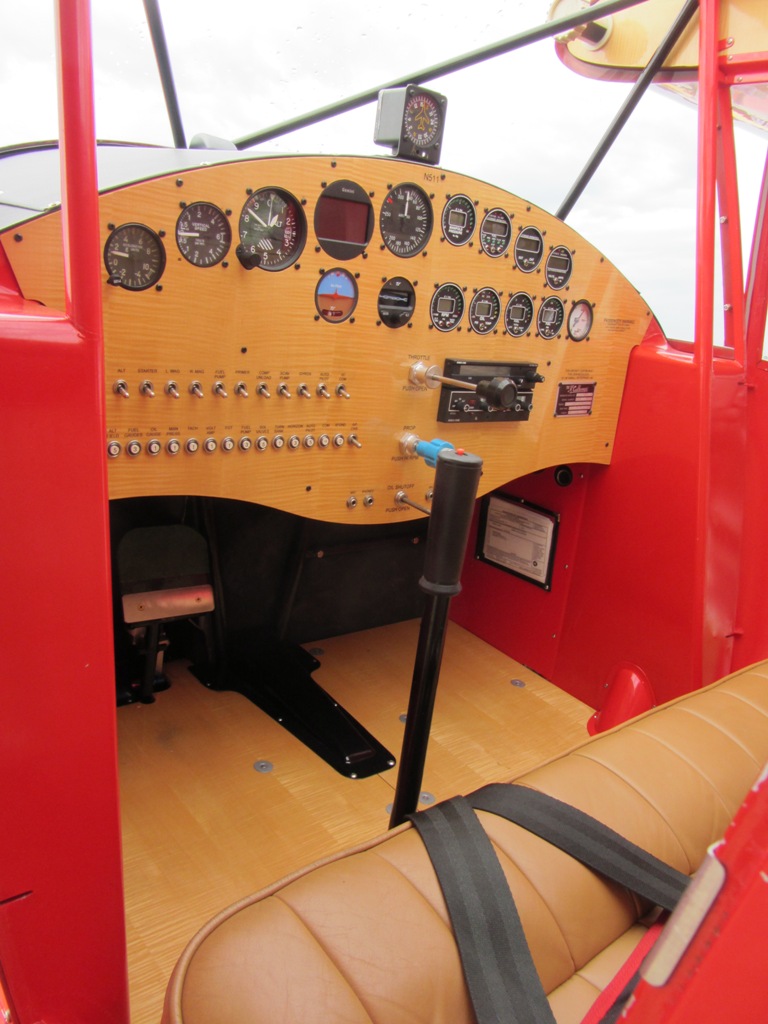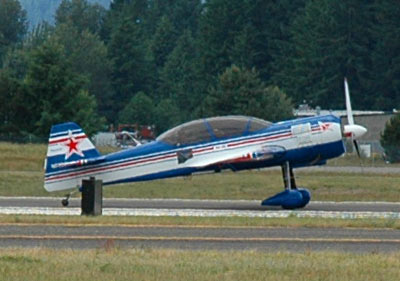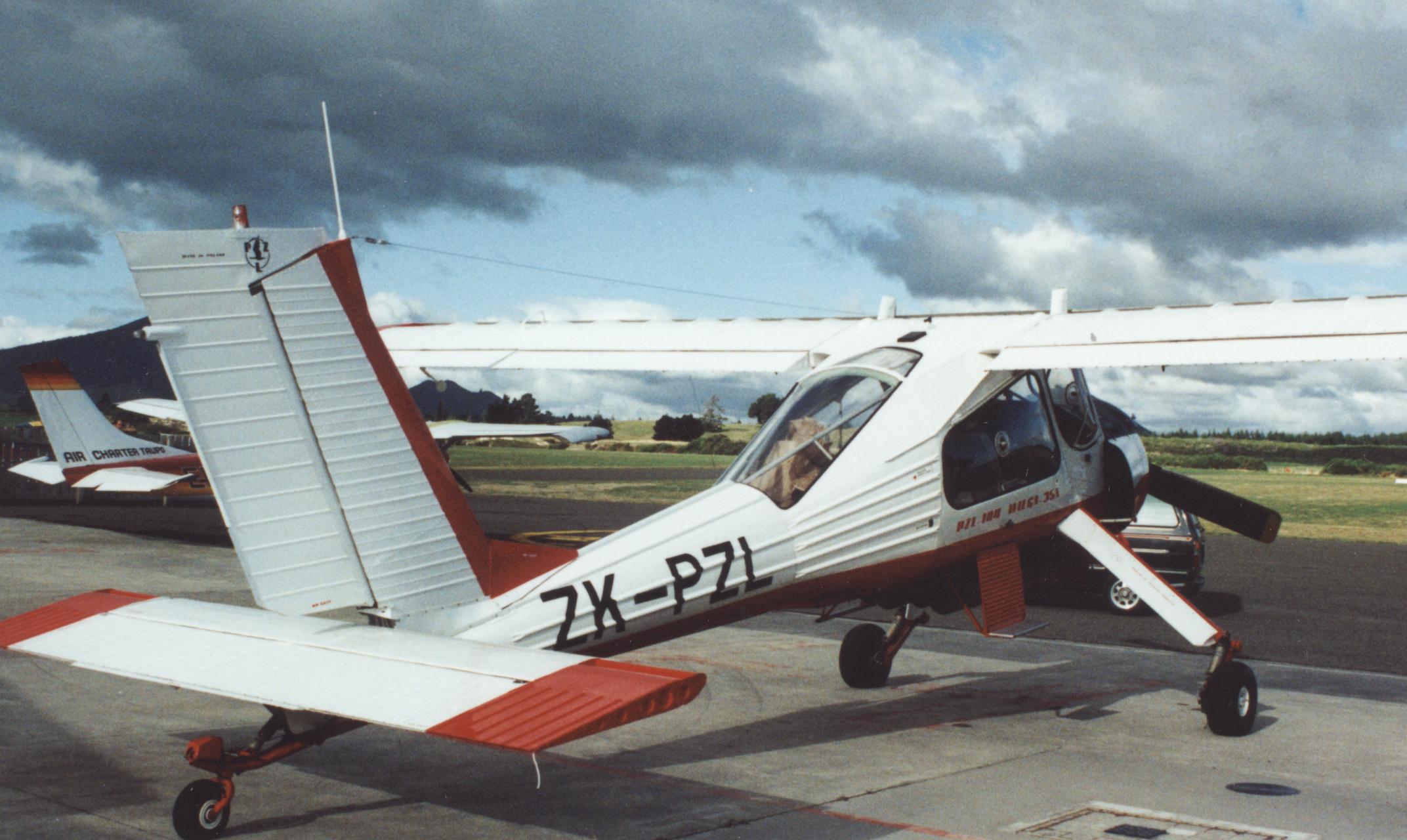|
M14P
The Vedeneyev M14P is a Russian nine-cylinder, four-stroke, air-cooled, petrol-powered radial engine. Producing , its design dates from the 1940s (Kotelnikov 2005), and is itself a development of the Ivchenko AI-14 engine. The engine has been used extensively by the Yakovlev and Sukhoi Design Bureaus. The M14P is also used in some experimental aircraft and kit designs such as the Murphy Moose, Radial Rocket, Pitts Model 12, and others. The M14PF is a version of the M14P. Design and development The engine's intake system uses a gear driven supercharger and an automatic-mixture type carburetor. Power is transmitted to the propeller via a reduction gearbox. In addition to the carburetor, the engine has a speed governor, two magnetos, mechanical fuel pump, generator, and an oil pump. It is started pneumatically, and remains fully operational during inverted flight. Unlike most American piston-type aero-engines, which turn to the right (clockwise) when viewed from the cock ... [...More Info...] [...Related Items...] OR: [Wikipedia] [Google] [Baidu] |
Pitts Model 12
The Pitts Model 12 (also known by its nicknames "Bolshoi", "Macho Stinker", "Pitts Monster") is a high performance aerobatic biplane designed around the Vedeneyev M14P/PF engine. The aircraft can be built from plans or as a kitplane, or can be bought ready-to-fly from the factory. Design and development The Pitts model 12 was designed by Curtis Pitts starting in 1993. Pitts presented his completed design on his 80th birthday in December 1995. The Pitts Model 12 is a biplane built using fabric covered welded steel tubing for the fuselage, and fabric covered wings with wood spars. The leading edge is made of formed plywood. The landing gear is solid aluminum Aluminium (aluminum in American and Canadian English) is a chemical element with the symbol Al and atomic number 13. Aluminium has a density lower than those of other common metals, at approximately one third that of steel. It ha .... Operational history , 59 examples had been completed and flown. V ... [...More Info...] [...Related Items...] OR: [Wikipedia] [Google] [Baidu] |
Murphy Moose
The Murphy Moose is a Canadian high-wing utility light aircraft produced in kit form by Murphy Aircraft of Chilliwack, British Columbia for amateur construction. The Moose can be purchased as a "quick-build" kit which comes partly pre-assembled.Vandermeullen, Richard: ''2011 Kit Aircraft Buyer's Guide'', Kitplanes, Volume 28, Number 12, December 2011, page 62. Belvoir Publications. ISSN 0891-1851Bayerl, Robby; Martin Berkemeier; et al: ''World Directory of Leisure Aviation 2011-12'', page 112. WDLA UK, Lancaster UK, 2011. ISSN 1368-485XTacke, Willi; Marino Boric; et al: ''World Directory of Light Aviation 2015-16'', page 118. Flying Pages Europe SARL, 2015. Builders can choose whether to equip their aircraft with the 269 kW (360 hp) Russian-built Vedeneyev M14P nine-cylinder radial or the horizontally-opposed 187 kW (250 hp) Lycoming O-540. Both engines allow the Moose to take off in roughly 180 m (600 ft). At least one owner has equipped their ... [...More Info...] [...Related Items...] OR: [Wikipedia] [Google] [Baidu] |
Kamov Ka-26
The Kamov Ka-26 (NATO reporting name Hoodlum) is a Soviet light utility helicopter with co-axial rotors. Development The Ka-26 entered production in 1969 and 816 were built. A variant with a single turboshaft engine is the Ka-126. A twin turboshaft-powered version is the Ka-226. (All the Ka-26/126/128/226 variants are code-named by NATO as "Hoodlum"). Design The fuselage of the Ka-26 consists of a fixed, bubble-shaped cockpit containing the pilot and co-pilot, plus a removable, variable box available in medevac, passenger-carrying and crop duster versions. The helicopter can fly with or without the box attached for flexibility. It is powered by two 325 hp (239 kW) Vedeneyev M-14V-26 radial engines mounted in outboard nacelles. The Ka-26 is small enough to land on a large truck bed. The reciprocating engines are more responsive than turboshaft engines, but require more maintenance. It runs mostly at 95% power in crop dusting with usually excess payload, leaving li ... [...More Info...] [...Related Items...] OR: [Wikipedia] [Google] [Baidu] |
Culp Special
The Culp Special is an American aerobatic homebuilt aircraft designed and produced by Culp's Specialties of Shreveport, Louisiana. The aircraft is supplied as a kit or in the form of plans for amateur construction.Purdy, Don: ''AeroCrafter - Homebuilt Aircraft Sourcebook, Fifth Edition'', page 144. BAI Communications, 15 July 1998. Design and development The Culp Special is intended to resemble an aircraft of the 1930s. It features a wire and strut-braced biplane layout, a two-seats-in-tandem open cockpit with dual windshields, fixed conventional landing gear with wheel pants, and a single engine in tractor configuration. The aircraft is made from welded steel tubing and wood, all covered in doped aircraft fabric. Its span wing has a wing area of . The standard engine used is the Russian Vedeneyev M14P nine cylinder, air-cooled, four stroke radial engine. The Culp Special has a typical empty weight of and a gross weight of , giving a useful load of . With full fuel o ... [...More Info...] [...Related Items...] OR: [Wikipedia] [Google] [Baidu] |
Kimball McCullocoupe
The Kimball McCullocoupe is a homebuilt aircraft built around the design of the Clipwing 110 Special Monocoupe. Development The McCulloCoupe is an aircraft built as an evolution of air racers starting with the Velie Monocoupe. The Monocoupe evolved into the Monocoupe 110, eventually flown as an air-racer with clipped wings. Ben Howard built a larger version of the Monocoupe, "Mister Mulligan". The Mullicoupe replicas were developed using Pratt & Whitney R-985 Wasp Junior engines. The McCulloCoupe uses a Vedeneyev M14P radial engine with features developed for the Pitts Model 12. Construction began in 2000, with the first flight in 2004. Design The McCulloCoupe has side-by-side configuration seating, a high-wing, conventional landing gear Conventional landing gear, or tailwheel-type landing gear, is an aircraft undercarriage consisting of two main wheels forward of the center of gravity and a small wheel or skid to support the tail.Crane, Dale: ''Dictionary of Aeronautic ... [...More Info...] [...Related Items...] OR: [Wikipedia] [Google] [Baidu] |
Khrunichev T-411 Aist
The Krunichev T-411 Aist ( en: ''Stork'') is a Russian light utility monoplane designed by the Russian company Aeroprogress and placed into production by the Khrunichev State Research and Production Space Center.Jackson 2003, p. 381. A version is marketed in the United States as the Aeroprogress T-411 Wolverine powered by a Continental TSIO-550-B. A homebuilt derivative design is the Washington T-411 Wolverine.Purdy, Don: ''AeroCrafter - Homebuilt Aircraft Sourcebook, Fifth Edition'', page 294. BAI Communications, 15 July 1998. Development The ROKS-Aero corporation was set up in Moscow in 1990 to design and manufacture general aviation aircraft, but was renamed Aeroprogress in 1993.Gunston 1995, p. 316. In 1992 ROKS-Aero started design of a single-engined light aircraft, the T-411 Aist 2. Construction of the prototype T-411 started in April 1993, making its maiden flight on 10 November 1993.Jackson 2003, p. 381. The Khrunichev State Research and Production Space Center set u ... [...More Info...] [...Related Items...] OR: [Wikipedia] [Google] [Baidu] |
Sukhoi Su-29
The Sukhoi Su-29 is a Russian two-seat aerobatic aircraft with a 268 kW (360 hp) radial engine. It was designed based on the Su-26 and inherited most of the design and technical features of its predecessor. Due to wide use of composite materials, which make up as much as 60% of the Su-29's aircraft structure, the empty weight is increased by only 50 kg (110 lb) over the single-seat Su-26's empty weight. The Su-29 is used for initial pilot aerobatics education, flight training, and participation of pilots in aerobatics competitions and air shows, as well as for maintaining flight skills of military and civil pilots. Operators ; *Argentine Air Force ordered eight Su-29ARs to equip the '' Cruz del Sur'' (Southern Cross) aerobatic team.Sap 2002, pp. 78–79. ; *Flying Bulls ; *DOSAAF ; *Czech aerobatic team Czech may refer to: * Anything from or related to the Czech Republic, a country in Europe ** Czech language ** Czechs, the people of the area ** Czech ... [...More Info...] [...Related Items...] OR: [Wikipedia] [Google] [Baidu] |
PZL-104 Wilga
PZL-104 Wilga ('' golden oriole'') is a Polish short-takeoff-and-landing (STOL) civil aviation utility aircraft designed and originally manufactured by PZL Warszawa-Okęcie, and later by European Aeronautic Defence and Space Company (EADS), who had acquired the original manufacturer during 2001. First flown on 24 April 1962 and entering service during the following year, the Wilga has evolved through many ever-improving versions during its continuous production from 1962 to 2006. The type was largely used by civil operators; those military air services that did fly the type typically used it as a trainer and liaison aircraft. In excess of 1,000 aircraft were produced prior to European Aeronautic Defence and Space Company (EADS) announcing on their website that production of the Wilga would cease in 2006. Development Origins The PZL-104 was designed for robust use in sports and civil aviation, with a strong emphasis on glider-towing and parachute training. On 24 April 1962, the ... [...More Info...] [...Related Items...] OR: [Wikipedia] [Google] [Baidu] |
Slepcev Storch
The Slepcev Storch ( en, Stork) is a Serbian type-certified, kit and ultralight STOL aircraft, designed by Yugoslavian-Australian Nestor Slepcev and currently produced by Storch Aircraft Serbia in several different versions. The ultralight version is a 3/4 scale replica of the Fieseler Fi 156 Storch of the Second World War and is supplied as a kit for amateur construction or as a complete ready-to-fly-aircraft.Bayerl, Robby; Martin Berkemeier; et al: ''World Directory of Leisure Aviation 2011-12'', pages 77 and 121. WDLA UK, Lancaster UK, 2011. ISSN 1368-485XBertrand, Noel; Rene Coulon; et al: ''World Directory of Leisure Aviation 2003-04'', page 162. Pagefast Ltd, Lancaster UK, 2003. ISSN 1368-485XTacke, Willi; Marino Boric; et al: ''World Directory of Light Aviation 2015-16'', page 128. Flying Pages Europe SARL, 2015. Design and development The aircraft was first flown in 1994. It was originally manufactured by Slepcev's company, Slepcev Aircraft Industry of Beechwood, ... [...More Info...] [...Related Items...] OR: [Wikipedia] [Google] [Baidu] |
Ivchenko AI-14
The Ivchenko AI-14 is a nine-cylinder, air-cooled, radial piston engine designed in the Soviet Union to power aircraft. A variant known as the M462 was produced under license by Avia. Variants ;AI-14: ;AI-14R:Underwent state trials in December 1950 and was used in many types of light aircraft, typically used with a two-bladed propeller and is started with compressed air. Several thousand were built. ;AI-14RA ;AI-14V: Variant for helicopters and other applications. ;AI-14VF: Variant for helicopters and other applications. ;AI-14RF: A variant uprated by Ivan Vedeneyev to 300 hp. Its further development is the Vedeneyev M14P family of engines. ;Avia M462: Powers the Zlín Z 37 agricultural aircraft. ;Zhuzhou HS-6: The designation for AI-14 Licence production in China. ;PZL AI-14R: A licensed version of the AI-14R, produced by WSK-Kalisz in Poland from 1956 until 2007. Applications * Aero L-60 Brigadýr (L-60S variant) *Antonov An-14 - AI-14RF * ICA IS-23 - AI-14RF *Kamov ... [...More Info...] [...Related Items...] OR: [Wikipedia] [Google] [Baidu] |
Sukhoi Su-26
The Sukhoi Su-26 is a single-seater aerobatic aircraft from the former Soviet Union, powered by a single radial reciprocating engine. The Su-26 has mid-mounted straight wings and fixed landing gear, the main gear mounted on a solid titanium arc. The Su-26 made its first flight in June 1984, the original four having a two-bladed propeller. The production switched to the Su-26M, with refined tail surfaces and a German-made MTV-9 3-blade composite propeller. Further refinements were made, and the model won both the men's and women's team prizes at the 1986 World Aerobatics Championships. The modified Su-26M3 with the new M9F engine dominated the 2003 and 2005 Aerobatic World Championships as well as the 2004 European Championships. The Su-26 has fully metric instruments, except for the altimeter. Specifications (Su-26) In popular culture '' IL-2 Sturmovik: Cliffs of Dover'' is a combat flight simulation video game mainly set in the Battle of Britain The Battle of Bri ... [...More Info...] [...Related Items...] OR: [Wikipedia] [Google] [Baidu] |
Altitude Radial Rocket
The Altitude Radial Rocket is an American amateur-built aircraft, produced by the Altitude Group of Overland Park, Kansas. The aircraft is supplied as a kit for amateur construction. Design and development The aircraft features a cantilever low-wing, a two-seats-in-tandem enclosed cockpit under a bubble canopy, fixed conventional landing gear or retractable tricycle landing gear and a single radial engine in tractor configuration. The aircraft is made from composites. The wing span and area as well as gross weight varies depending on the model. The Radial Rocket's recommended engine power range is and the standard engine used is the Vedeneyev M-14P four-stroke powerplant. Operational history , six examples had been registered in the United States with the Federal Aviation Administration The Federal Aviation Administration (FAA) is the largest transportation agency of the U.S. government and regulates all aspects of civil aviation in the country as well as over s ... [...More Info...] [...Related Items...] OR: [Wikipedia] [Google] [Baidu] |
.jpg)

-_by-RaBoe_01.jpg)






